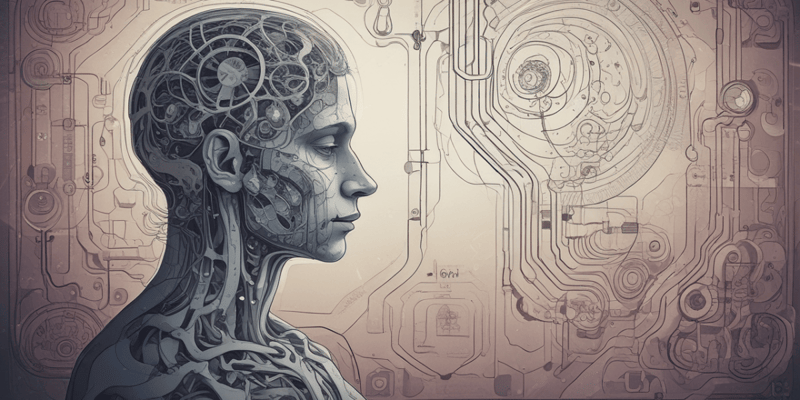44 Questions
What is the patient's current occupation?
Graduate student in social work
What is the patient's family history?
Unknown
How has the patient's alcohol consumption changed recently?
It has increased significantly
What is the patient's blood pressure?
122/86 mmHg
How would you describe the patient's speech?
Rapid and loud
What is the patient's attitude towards their friends?
Angry
What is the patient's mood?
Euphoric
How would you describe the patient's thought process?
Tangential and circumstantial
What is the primary concern of Kevin's roommates based on the chief complaint?
Kevin's lack of sleep
What is unusual about Kevin's behavior according to his roommates
All of the above
What is the objective of the mental status exam?
To evaluate the patient's mental health
What is the recommended approach to documenting the mental status exam?
Using a systematic method
What is the significance of Kevin's lack of sleep in the past 3 or 4 weeks?
It may be a sign of mania
What is the primary goal of the mental status exam?
To assess the patient's mental health
What is unusual about Kevin's purchases?
He cannot afford these kinds of items
What is the significance of Kevin's irritability and explosiveness?
It may be a sign of mania
What percentage of patients who walk into your office may have a mental health disorder?
1 in 4
What is the primary concern when dealing with patients who have mental health disorders?
Their suicidal or homicidal tendencies
What is the most common reason for patients to visit their primary care physician?
Mental health disorders
What is the importance of screening for mental health disorders in primary care?
To provide early intervention and treatment
What is the role of the primary care physician in managing mental health disorders?
To diagnose and manage mental health disorders
What is the benefit of early detection of mental health disorders?
Improved patient outcomes
What is the most likely reason for the patient's presentation to the emergency department?
The patient's friends are concerned about his recent change in behavior.
What is the patient's current mental status?
Euphoric and irritable
What is the significance of the patient's tangential thought processes?
It suggests a thought disorder.
What is the patient's attitude towards their friends' concerns?
The patient is angry with their friends for involving others.
What is the patient's response to the examiner's request to sit down?
The patient refuses to sit down.
What is the significance of the patient's mismatched socks?
It indicates a lack of attention to detail.
What is the patient's perceived self-image?
Grandiose and superior.
What is the most likely underlying diagnosis based on the patient's presentation?
Bipolar disorder.
What is the primary reason for documenting the mental status exam in a systematic manner?
To facilitate communication among healthcare professionals
Which of the following behaviors is most suggestive of a mental health disorder?
All of the above
What is the primary goal of the mental status exam in this patient?
To determine the patient's risk of harm to themselves or others
Which of the following components is NOT typically included in the mental status exam?
Medical history
What is the significance of the patient's report of multiple new sexual partners?
It suggests a change in the patient's usual behavior
What is the primary reason for performing a mental status exam in this patient?
To assess the patient's risk of harm to themselves or others
Which of the following is a key component of the mental status exam?
Evaluation of the patient's cognitive function
What is the significance of the patient's lack of sleep over the past 3 or 4 weeks?
It may be contributing to the patient's changed behavior
What is the primary implication of 1 in 4 patients who walk into your office having a mental health disorder?
A need for more comprehensive mental health screenings.
What is the significance of identifying mental health disorders in primary care patients?
It enables early detection and treatment of mental health disorders.
What is the potential consequence of failing to identify mental health disorders in primary care patients?
Increased healthcare costs and utilization.
What is the role of the primary care physician in managing mental health disorders?
To provide initial screening and referral to specialized care.
What is the primary benefit of early detection of mental health disorders?
Improved patient outcomes and quality of life.
What is the implication of the high prevalence of mental health disorders in primary care patients?
An increased importance of primary care physicians in managing mental health disorders.
Study Notes
Mental Status Examination
- The mental status exam has several components that must be illustrated, performed, and interpreted by healthcare professionals.
Patient Case Scenario
- A 24-year-old uncooperative man is brought to the emergency department by his roommates, who are concerned about his unusual behavior.
- He has not slept for 3-4 weeks, stays up all night cleaning, and has made extravagant purchases despite limited financial means.
- He has also been bragging about having slept with three different women in a week, which is uncharacteristic of him, and has been irritable and explosive.
Patient History
- The patient has no known medical problems, unknown past surgical history, and no family history of medical or psychiatric disorders.
- He is a graduate student in social work and has been drinking a lot of alcohol for the past two weeks.
Vitals and Mental Status Exam
- Vital signs: Height 60”, Weight 179, Temperature 98, Respiratory rate 24, Blood pressure 122/86, Oxygen saturation 96%.
- The patient appears alternately irritable and elated, wearing bright orange and red clothing, and has mismatched socks.
- He paces the room, refuses to sit down, and speaks rapidly and loudly, making it hard to interrupt him.
- He claims to be in a great mood and is angry with his friends for bringing him to the emergency department.
- He has tangential thought processes and denies any suicidal or homicidal thoughts.
Clinical Pearls
- 1 in 4 patients who walk into a healthcare office may have a mental health disorder.
Mental Status Examination
- The mental status exam has several components that must be illustrated, performed, and interpreted by healthcare professionals.
Patient Case Scenario
- A 24-year-old uncooperative man is brought to the emergency department by his roommates, who are concerned about his unusual behavior.
- He has not slept for 3-4 weeks, stays up all night cleaning, and has made extravagant purchases despite limited financial means.
- He has also been bragging about having slept with three different women in a week, which is uncharacteristic of him, and has been irritable and explosive.
Patient History
- The patient has no known medical problems, unknown past surgical history, and no family history of medical or psychiatric disorders.
- He is a graduate student in social work and has been drinking a lot of alcohol for the past two weeks.
Vitals and Mental Status Exam
- Vital signs: Height 60”, Weight 179, Temperature 98, Respiratory rate 24, Blood pressure 122/86, Oxygen saturation 96%.
- The patient appears alternately irritable and elated, wearing bright orange and red clothing, and has mismatched socks.
- He paces the room, refuses to sit down, and speaks rapidly and loudly, making it hard to interrupt him.
- He claims to be in a great mood and is angry with his friends for bringing him to the emergency department.
- He has tangential thought processes and denies any suicidal or homicidal thoughts.
Clinical Pearls
- 1 in 4 patients who walk into a healthcare office may have a mental health disorder.
A 24-year-old man is brought to the emergency department due to his unusual behavior, including lack of sleep, excessive cleaning, and extravagant purchases. Evaluate the patient's mental status and diagnose the potential disorder.
Make Your Own Quizzes and Flashcards
Convert your notes into interactive study material.
Get started for free



